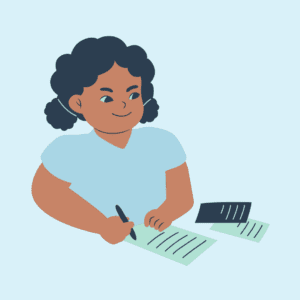After fidget spinners came on the scene, teachers began banning self-regulation tools from the classroom. Students misused them and teachers weren’t prepared for them. These tools get a bad rap when not used properly. Without clear usage rules, they can be a disaster and a distraction. With an effective management plan, using fidget tools in the classroom increases focus and calms students. They can work FOR you, rather than against you and your behavior management efforts. I think you will find that fidgets are for everyone, not just those with sensory processing needs.
Suggested Rules for Managing Fidgets
- Keep tools on the desk.
- Do not throw tools.
- No chewing tools or putting in mouth.
- Don’t share your fidget with others.
- Use quietly.
Students will fidget at their desks with or without fidget tools. They chew their pencils, take the wire out of their spirals, fold paper, tap their feet on the chair legs, spin their rulers and do all kinds of interesting things to their school supplies. Fidget tools provide an appropriate outlet for students with established rules to keep distractions at bay.
9 Types of Regulation Tools for the Classroom

Squeezables
Students love to squeeze things. The squeezing and releasing of muscles relieves stress and calms the student. Examples include stress balls, pool noodle slices, and any small object that fits in the hand.
Mindful Manipulatives
Some tools are simple and don’t take a lot of thought to complete. Examples of these relaxing tools include fidget cubes, tangents, pipe cleaners, and sand trays.
Sounds
Soothing sounds can calm a student immediately. Music has amazing calming effects on our bodies. Examples of things to include are sound machines with spa music or nature sounds and headphones connected to soothing music.
Brain Stimulation
Focusing on a brain teaser can be just enough distraction to soothe the brain and rid it of other more unpleasant distractions. Examples include a Rubic’s cube, puzzles, task cards and riddles.
Creative Outlets
The act of creating something is very calming. Try out journals, coloring books, sketch pads, clay and any other craft.
Visual Stimulation
Watching things move and change is satisfying. Slow moving objects are very calming. Examples include glitter jars, liquid timers, sand timers, and a slinky.
Stretchy Things
There’s just something soothing about pulling on something and watching it return to it’s original shape. Examples include a rubber ball, stretchy bands, gummy worms, and other stretchy toys.
Tactile Stimulation
Unexpected surfaces and interesting textures are pleasing to the hand and provide calming satisfaction. Examples of fun things to touch include “mermaid” pillows, bubble wrap, soft pillows, sand trays, slime and any bumpy toys.
Breathing
Focused breathing brings in the oxygen we need for improved concentration, better memory, and focus. Examples include visual cards with breathing tips, bubbles, a kazoo, party blower, and pinwheels. Try a free breathing activity sheet for grades 1-3 and 4-8.

You might be overwhelmed with this list and not sure if you are ready to add these tools in the classroom. My advice would be to start small. Choose one fidget tool and establish clear rules that work for you and your students. Decide if you want to let every student use them or just a few at a time. Figure out when they will be allowed and for how long. Once you decide what you can live with, you can expand and add more.
Another way to do this is to set up a calm down corner in the classroom. This allows tools in the classroom without bringing them to the desks. Read more about setting up your calm down corner from Laura of Social Emotional Workshop.
Comment below with how you have gotten fidgets and other self-regulation tools to work in your school.






